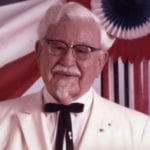 Creepy
Creepy  Creepy
Creepy  Technology
Technology 10 Scientific Breakthroughs of 2025 That’ll Change Everything
 Our World
Our World 10 Ways Icelandic Culture Makes Other Countries Look Boring
 Misconceptions
Misconceptions 10 Common Misconceptions About the Victorian Era
 Mysteries
Mysteries 10 Strange Unexplained Mysteries of 2025
 Miscellaneous
Miscellaneous 10 of History’s Most Bell-Ringing Finishing Moves
 History
History 10 Great Escapes That Ended Right Back in Captivity
 Weird Stuff
Weird Stuff 10 Fascinating Things You Might Not Know About Spiders
 Food
Food 10 Everyday Foods You Didn’t Know Were Invented by the U.S. Military
 History
History 10 Odd Things Colonial Americans Kept at Home
 Creepy
Creepy 10 More Representations of Death from Myth, Legend, and Folktale
 Technology
Technology 10 Scientific Breakthroughs of 2025 That’ll Change Everything
 Our World
Our World 10 Ways Icelandic Culture Makes Other Countries Look Boring
Who's Behind Listverse?

Jamie Frater
Head Editor
Jamie founded Listverse due to an insatiable desire to share fascinating, obscure, and bizarre facts. He has been a guest speaker on numerous national radio and television stations and is a five time published author.
More About Us Misconceptions
Misconceptions 10 Common Misconceptions About the Victorian Era
 Mysteries
Mysteries 10 Strange Unexplained Mysteries of 2025
 Miscellaneous
Miscellaneous 10 of History’s Most Bell-Ringing Finishing Moves
 History
History 10 Great Escapes That Ended Right Back in Captivity
 Weird Stuff
Weird Stuff 10 Fascinating Things You Might Not Know About Spiders
 Food
Food 10 Everyday Foods You Didn’t Know Were Invented by the U.S. Military
 History
History 10 Odd Things Colonial Americans Kept at Home
10 Strange Traditions and Rituals on Transatlantic Ships
Transatlantic voyages weren’t just about getting from point A to point B—they were rich with traditions, rituals, and customs, many of which reflected the anxieties, superstitions, and camaraderie of life at sea. Whether designed to ward off bad luck, celebrate milestones, or bring passengers together, these rituals paint a vivid picture of what life was like aboard these historic journeys.
Here are 10 fascinating and strange traditions that made transatlantic voyages a unique experience.
Related: 10 Fabled Shipwrecks That Have Yet to Be Found
10 The Yarn Goodbye
One of the most touching traditions of transatlantic voyages was the “yarn goodbye.” In the 19th and early 20th centuries, as ships prepared to depart, passengers and their loved ones on the dock would each hold one end of a ball of yarn. As the ship pulled away, the yarn unraveled, symbolizing the bittersweet separation. This custom was especially common among immigrants leaving Europe for America, many of whom knew they were likely saying goodbye to their families forever. Later generations saw the yarn replaced with streamers.
The unraveling yarn wasn’t just symbolic; it gave families a tangible connection during those final moments. Crowds at ports like Liverpool and Hamburg were often filled with people holding colorful strands of yarn, creating a poignant scene of connection and loss. Historical photographs from the era show families clutching the threads tightly until the yarn finally snapped or ran out. In some cases, passengers kept the remaining yarn as a memento of their loved ones back home, a small but meaningful piece of the life they had left behind.[1]
9 The Crossing the Line Ceremony
The “Crossing the Line” ceremony, performed for those crossing the equator for the first time, was a flamboyant and often chaotic tradition on many transatlantic ships. This ritual transformed the ship into a stage for theatrical antics, with senior crew members dressing as King Neptune, his wife Amphitrite, and their court. First-timers, known as “pollywogs,” underwent an initiation involving mock trials, messy pranks, and elaborate hazing rituals. These rites could include being dunked in seawater, smeared with food, or made to wear ridiculous costumes.
Although this tradition was more common on naval and merchant ships, it occasionally appeared on transatlantic liners, especially during voyages that dipped into the Southern Hemisphere. On the luxury liners, the ceremony often had a more refined touch, with Neptune’s court appearing in extravagant costumes crafted by the ship’s crew.
In steerage, however, the ceremony could turn rowdy, with passengers improvising their own versions of the event. Some accounts describe heated disputes breaking out during the chaos, while others recall it as the highlight of long and monotonous journeys. The tradition served as a morale booster and an unforgettable experience for travelers venturing into new territories for the first time.[2]
8 Wearing Amulets for Safe Passage
Superstition played a powerful role in the lives of those embarking on transatlantic voyages. Passengers and sailors alike carried amulets and charms believed to protect them from the dangers of the open sea. These items varied widely depending on cultural and religious backgrounds. Catholic passengers often carried rosaries, scapulars, or medals of St. Christopher, the patron saint of travelers. Others relied on talismans such as coins, seashells, or even small bottles of holy water blessed by clergy before departure.
Sailors had their own superstitions, refusing to set sail on Fridays—considered an unlucky day—or avoiding actions like whistling on deck, which was thought to “whistle up” storms. Immigrants leaving Europe often combined religious rituals with these superstitions, believing that their charms could safeguard them not only from shipwrecks but also from illness or bad fortune in their new homeland. Reports from Ellis Island staff mention passengers clutching these items as they disembarked, a final reminder of the spiritual protection they had relied on throughout their perilous journey.[3]
7 The Last Night’s Concert
For many transatlantic passengers, the final night aboard the ship was marked by a celebratory concert or performance. On luxury liners like the RMS Titanic and RMS Queen Mary, first-class passengers were treated to elegant soirées with live orchestras, formal attire, and elaborate menus featuring champagne toasts. These events showcased the height of luxury and entertainment, providing wealthy travelers with a glamorous sendoff before arriving at their destinations.
In steerage, the celebrations were more modest but no less heartfelt. Passengers often organized impromptu concerts, with folk songs and traditional dances reflecting their diverse cultural backgrounds. Immigrants from Ireland, Italy, and Eastern Europe brought their own musical traditions, turning the lower decks into vibrant hubs of activity.
These gatherings became opportunities to forge friendships and share stories, even if language barriers made communication difficult. In some cases, passengers used these concerts to perform heartfelt farewells to the life they were leaving behind, with songs that carried a mix of hope, nostalgia, and longing.[4]
6 Saltwater Showers as a Rite of Passage

On transatlantic voyages, where fresh water was a precious commodity, saltwater showers became both a practical necessity and a quirky tradition. Passengers, especially those in steerage, often lined up on deck to be doused with buckets of seawater or to stand under makeshift saltwater pumps. These showers were typically used to cool off during warm weather or as a way to freshen up after days spent in cramped, unsanitary quarters below deck.
Saltwater showers often carried symbolic meaning for sailors, acting as a rite of passage for new recruits or marking significant milestones during the voyage. For passengers, they occasionally became a source of levity and community, with children splashing each other and adults laughing as they braved the icy water. On some ships, saltwater showers were a daily routine, while on others, they were reserved for special occasions. First-class passengers rarely participated, as they had access to private baths and fresh water, underscoring the sharp contrasts in living conditions aboard transatlantic ships.[4]
5 Tossing Coins into the Ocean
A long-standing maritime tradition involved passengers tossing coins into the sea for good luck at the start of their journey. The practice was rooted in ancient beliefs that offerings to the gods of the ocean—such as Neptune or Poseidon—could ensure calm waters and a safe crossing. On transatlantic voyages, this ritual became especially meaningful for passengers who viewed it as a way to honor the unknown dangers ahead.
For many immigrants, tossing a coin into the ocean was more than just a superstitious act; it symbolized leaving behind their old lives. Some families would toss coins engraved with initials or dates, treating it as a form of spiritual insurance for the journey. Historical accounts describe children being particularly excited about the ritual, eager to see their coin disappear into the waves. Crew members sometimes joked that the sea’s “collection” grew significantly richer with every voyage, but the practice held deep personal significance for those making the crossing.[6]
4 Dining Salutes and Table Etiquette
Dining aboard transatlantic ships was as much about ritual as it was about sustenance, particularly for first-class passengers. Meals were multi-hour affairs featuring up to ten courses, served with precision by tuxedoed waiters. It was common for passengers to participate in formal dining salutes, raising glasses to the captain and crew while adhering to strict table etiquette. Even the seating arrangements reflected social hierarchies, with prominent figures seated closest to the captain.
In steerage, the dining experience was far less glamorous. Meals often consisted of bread, porridge, salted meat, and potatoes, served in communal areas below deck. However, these humble meals were not without their own rituals. Immigrant families often shared stories and songs over their food, and passengers occasionally swapped recipes or ingredients to introduce each other to their culinary traditions. The stark contrast between the upper-deck elegance and the simpler, communal atmosphere of steerage created a microcosm of the class divides that defined transatlantic life.[7]
3 Blessing the Ship Before Departure
Before a transatlantic ship left port, it was customary to perform a blessing to ensure safe passage. In Catholic countries, priests often led the ritual, sprinkling holy water on the ship’s deck and offering prayers for calm seas and a successful journey. Passengers, especially immigrants leaving Europe for America, frequently participated by bringing their own religious items, such as crucifixes or prayer cards, which they would have blessed before boarding.
The practice wasn’t limited to Catholicism. Jewish passengers often recited the Tefilat HaDerech (Traveler’s Prayer), while others performed personal rituals rooted in local folklore. In some ports, dockworkers and sailors also participated in these blessings, seeing them as a communal act of goodwill. Historical records reveal that during periods of heightened maritime disasters, these blessings took on an almost desperate urgency, with entire families gathering at the port to pray together before the ship set sail.[8]
2 The Iceberg Vigil
After the Titanic tragedy in 1912, a new, unofficial tradition emerged on transatlantic voyages: the iceberg vigil. Passengers—particularly those traveling in steerage, where fears of maritime disasters loomed larger—would gather on deck at night to keep watch for icebergs. Although ships were increasingly equipped with advanced navigational tools and safety measures, the memory of the Titanic’s sinking remained fresh, making this a way for passengers to feel actively involved in their own safety.
The vigil often became a communal activity. Passengers wrapped themselves in blankets, shared stories about their families, and exchanged nervous jokes to lighten the mood. Crew members occasionally joined in, adding their expertise to the group’s efforts. While these gatherings rarely had any practical effect on the voyage, they provided a sense of solidarity and control when many felt at the mercy of the vast, unpredictable ocean.[9]
1 Tying Ribbons to the Mast

A lesser-known but deeply symbolic tradition among some passengers involved tying ribbons to the ship’s mast or railings before departure. Each ribbon represented a wish, hope, or prayer for the voyage, with some passengers tying multiple ribbons for different desires—safe passage, reunion with loved ones, or success in their new home. The sight of vibrant ribbons fluttering in the wind became a striking visual reminder of the hopes carried by the ship and its passengers.
This tradition was particularly popular among immigrants and sailors from Central and Eastern Europe, where ribbons often held cultural significance as symbols of protection and good fortune. Ribbons were sometimes tied in specific colors to represent different wishes, such as red for health or blue for calm waters. By the time the ship reached its destination, the ribbons were often weathered by the salty air and ocean spray, serving as a poignant metaphor for the trials endured during the journey.[10]








